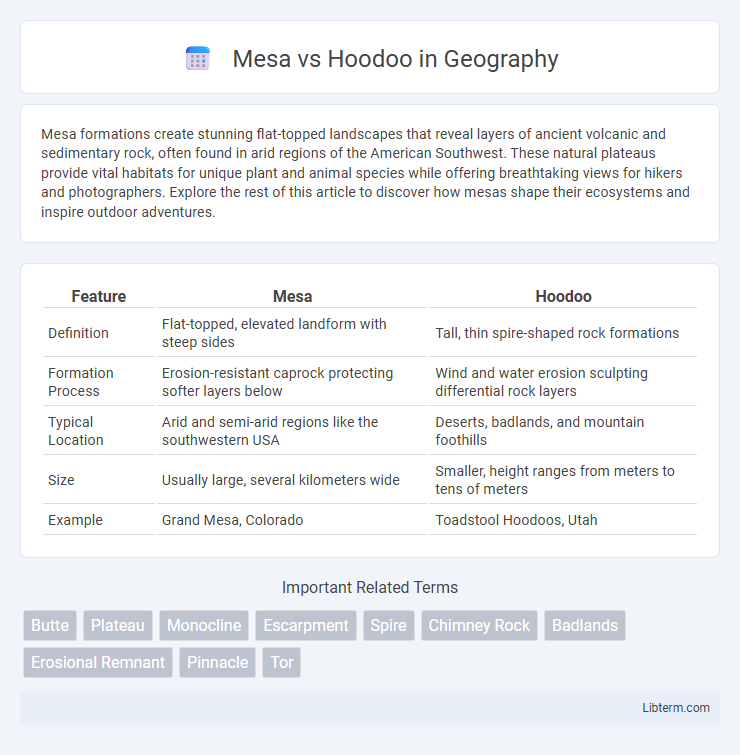Mesa formations create stunning flat-topped landscapes that reveal layers of ancient volcanic and sedimentary rock, often found in arid regions of the American Southwest. These natural plateaus provide vital habitats for unique plant and animal species while offering breathtaking views for hikers and photographers. Explore the rest of this article to discover how mesas shape their ecosystems and inspire outdoor adventures.
Table of Comparison
| Feature | Mesa | Hoodoo |
|---|---|---|
| Definition | Flat-topped, elevated landform with steep sides | Tall, thin spire-shaped rock formations |
| Formation Process | Erosion-resistant caprock protecting softer layers below | Wind and water erosion sculpting differential rock layers |
| Typical Location | Arid and semi-arid regions like the southwestern USA | Deserts, badlands, and mountain foothills |
| Size | Usually large, several kilometers wide | Smaller, height ranges from meters to tens of meters |
| Example | Grand Mesa, Colorado | Toadstool Hoodoos, Utah |
Definition of Mesa and Hoodoo
A mesa is a flat-topped, steep-sided landform typically found in arid regions, formed by erosion leaving behind a resistant rock layer that caps the structure. Hoodoos are tall, thin spires of rock that protrude from the bottom of arid basins and badlands, created through differential erosion of sedimentary rock layers. Both features illustrate the power of weathering and erosion but differ significantly in shape and formation processes.
Geological Formation Processes
Mesa formations result primarily from horizontal layers of sedimentary rock undergoing differential erosion, where hard rock layers resist weathering while softer layers erode away. Hoodoos form through a combination of frost wedging and rain erosion, sculpting narrow spires as softer rock beneath a protective capstone erodes at different rates. Both feature sedimentary origins but differ in erosion dynamics, with mesas exhibiting broad, flat tops and hoodoos characteristically tall, slender shapes.
Key Physical Characteristics
Mesa features flat-topped landforms with steep, often vertical cliffs composed of layered sedimentary rock, while Hoodoos are tall, thin spires of rock that taper upward, formed by differential erosion. The height of mesas typically ranges from hundreds to thousands of feet and exhibits broad, expansive plateaus, whereas hoodoos vary from a few feet to several dozen feet high with irregular, weathered shapes. Both geological formations showcase unique erosion patterns but differ significantly in scale, shape, and structural composition.
Locations Around the World
Mesa formations, characterized by their flat tops and steep sides, are predominantly found in arid regions like the southwestern United States, parts of Mexico, and Australia. Hoodoos, with their distinctive spire shapes, are most famously located in Bryce Canyon National Park, Utah, and also appear in regions such as the Badlands of Canada and parts of the Sahara Desert. Both geological structures offer unique landscapes shaped by erosion but are distributed across diverse global locations reflecting varying climatic and geological histories.
Historical and Cultural Significance
Mesa and Hoodoo formations both hold deep historical and cultural significance, especially for Indigenous peoples such as the Navajo and Hopi tribes, who regard them as sacred landscapes imbued with spiritual meaning. These landforms often served as landmarks, ceremonial sites, and symbols in oral traditions, reflecting the connection between native cultures and the natural environment. Archaeological evidence around these sites reveals ancient habitation and ritual use, emphasizing their enduring influence in regional heritage and identity.
Erosion and Weathering Differences
Mesa formations resist erosion due to their hard, flat rock layers that protect underlying softer sediments, resulting in broad, flat-topped hills. Hoodoos emerge through differential weathering, where softer rock erodes faster than harder caprock, creating tall, thin spires. The distinct erosion patterns in mesas maintain their plateaus, while hoodoos continuously evolve as weathering selectively shapes their unique shapes.
Prominent Examples of Mesas
Prominent examples of mesas include the iconic Grand Mesa in Colorado, known as the largest flat-topped mountain worldwide, and the Mesa Verde in the southwestern United States, renowned for its ancient Ancestral Puebloan cliff dwellings. Mesas are characterized by their broad, flat tops and steep cliffs, formed through erosion-resistant layers of rock. In contrast, hoodoos are tall, thin spires of rock that develop from differential erosion, commonly found in areas like Bryce Canyon National Park in Utah.
Prominent Examples of Hoodoos
Hoodoos, characterized by their tall, thin spires of rock, are prominently found in Bryce Canyon National Park, where formations like Thor's Hammer and the Queen Victoria Hoodoo showcase their unique erosional shapes. In Drumheller, Alberta, the Hoodoos display striking sedimentary layers shaped by wind and water, making them a significant natural landmark. These natural structures, unlike broad flat-topped mesas, highlight the intricate processes of weathering that create delicate pinnacles in arid environments.
Ecological Impact and Biodiversity
Mesa landscapes support diverse plant and animal species due to their stable soil and microclimates, fostering rich biodiversity and ecological resilience. Hoodoos, with their unique rock formations and limited soil cover, create specialized habitats that support niche species adapted to harsh, arid conditions, contributing to ecological diversity in desert ecosystems. Both landforms play crucial roles in maintaining regional biodiversity by providing distinct ecological niches and supporting species variation across different environments.
Visiting and Exploring Mesas vs Hoodoos
Visiting mesas offers expansive panoramic views and opportunities for hiking across flat-topped elevations with steep sides, providing unique geological formations and diverse desert ecosystems. Exploring hoodoos involves navigating narrow trails through striking spire-shaped rock formations, which present intricate patterns and vibrant colors formed by erosion. Both landscapes deliver distinct experiences: mesas emphasize broad scenic vistas and plateau exploration, while hoodoos highlight detailed rock sculpting and close-up geological fascination.
Mesa Infographic

 libterm.com
libterm.com